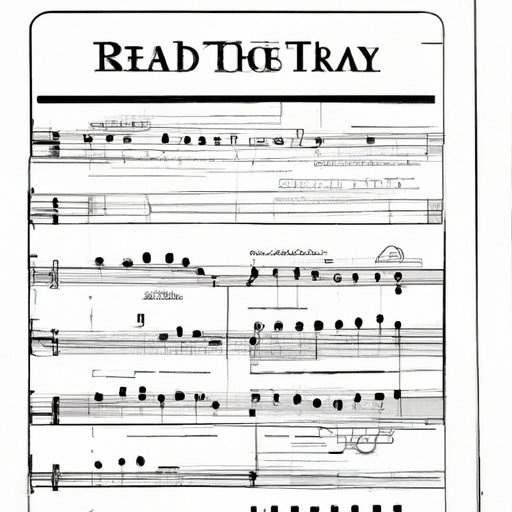
Introduction
If you’re looking to improve your guitar playing or expand your musical repertoire, learning how to read guitar tabs is an essential skill. Guitar tabs are a type of sheet music that uses a different notation system than traditional sheet music. With tabs, you can easily learn how to play your favorite songs, solos, and riffs without having to read sheet music. In this article, we’ll break down the basics of how to read tabs and provide tips for mastering this skill.
Reading Tabs Made Easy: A Beginner’s Guide to Understanding Tablature
One of the most challenging things about reading tabs is understanding all of the symbols and markings. Let’s break down the basics:
- The lines represent the strings on the guitar, with the bottom (thinnest) string being the top line and the top (thickest) string being the bottom line.
- The numbers on the lines represent the frets you should play. For example, the number 3 on the first (top) line means you should place your finger on the third fret of the thinnest string.
- X’s indicate strings that should not be played, while O’s indicate open strings.
- Hammer-ons, pull-offs, and slides are typically marked with an “h,” “p,” or “s,” respectively.
If you come across a particularly challenging tab, there are some things you can do to make it easier to understand. Try playing along with a recording of the song, slowing down the tempo, or breaking it down into smaller sections.
Tab Reading Basics: A Step-by-Step Guide for Guitarists
Learning how to read tabs requires some practice, but it’s not as difficult as it may seem at first. Follow these simple steps:
- Start by identifying the basic elements of the tab, such as the lines, numbers, and symbols.
- Next, learn how to read chord notations. Chord diagrams are often represented as a grid of dots, with each dot representing where you should place your fingers on the fretboard.
- Read the tab from left to right, playing each note or chord as you go.
- Pay attention to timing and rhythm. Tabs often include symbols that indicate the length of each note or chord.
Don’t get discouraged if you don’t get it right away. Try practicing these basics with simple songs and pieces until you feel comfortable reading tabs.
Decoding Tabs: Tips and Tricks for Mastering the Guitar Tablature
Once you’ve mastered the basics of tab reading, there are some advanced techniques you can use to improve your skills. One of the most important is learning how to recognize picking patterns, such as alternate picking or sweep picking. You can also try practicing with different types of tabs, such as those that include notation for strumming or fingerpicking. Another good practice is to study the tabs of your favorite guitarists to see how they approach certain techniques or songs.
Another helpful technique is to practice sight-reading tabs. This involves playing through a tab without stopping, even if you make mistakes. The goal is to improve your ability to read tabs quickly and accurately.
Unlocking the Power of Tabs: Techniques for Learning to Read Tablature
Learning to read tabs isn’t just about playing back what you see on the page. It’s also about using tabs as a tool for learning and expanding your musical skills. Here are some ways to incorporate tabs into your practice routine:
- Use tabs to learn new songs, paying close attention to the timing and phrasing of the notes.
- Try using the tabs of your favorite songs as a template for writing your own music.
- Use tabs to practice playing along with other musicians, whether in a band or a jam session.
Remember, tabs are just one tool in your musical toolkit. Don’t be afraid to experiment with different learning methods and approaches to see what works best for you.
Getting Started with Tablature: Essential Tips for Musicians of All Levels
Finally, here are some common mistakes to avoid when reading tabs:
- Assuming that tabs are always accurate. Tabs can be incorrect or incomplete, so use them as a starting point rather than the final word on a song.
- Forgetting to listen to the original recording. Tabs can give you an idea of how to play a song, but the original recording is the best way to get an accurate sense of the timing and phrasing.
- Over-relying on tabs. Tabs can be a helpful learning tool, but they shouldn’t be the only thing you use to develop your musical skills. Make sure to also practice ear training, sight-reading, and other techniques.
Finally, here are some online resources for finding and analyzing tabs:
Conclusion
Reading tabs is an essential skill for any guitarist, whether you’re a beginner or an experienced player. By following the tips and techniques outlined in this article, you can improve your tab reading skills and expand your musical horizons. Remember to practice regularly and experiment with different learning methods until you find what works best for you.




